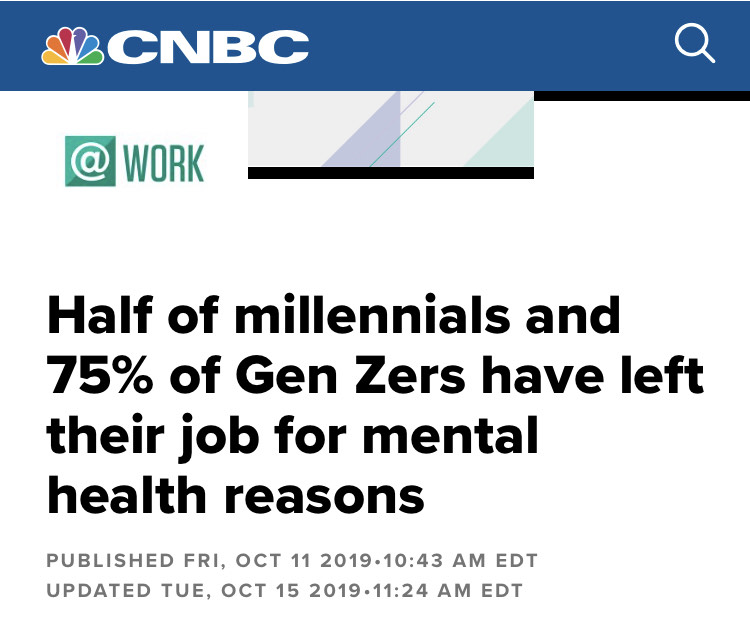You see these stats & they hit you…they jar you, don’t they? When I see round #s like 75% or 50% I get a little skeptical…seems too convenient. That said, even if those aren’t the exact #s, the point is a major one – our youngest generations entering the workforce are dealing w MH burnout way early in their careers.
Directly taken from this article/study, here are the three factors referenced: a) rising work loads, b) limited staff, c) longer hours.
No one can deny that these are some of the factors. And yes many other obvious ones can make the list, like – joining the workforce w more student debt than ever before, smart phones which means you are on-call 24/7, a “get ahead at all costs” society that rewards the same thing that causes burnout, social media which has you on edge comparing your successes or lack thereof to fam & friends, etc.
BUT, neither this article – nor most of the reporting done arnd this topic address the elephant in the room: CULTURE, starting at the top, to help employees deal w these added pressures, is the make or break factor as to how your employees are able to best deal w MH at work.
I worked FOR many diff leaders as I traveled arnd the country w sports. Since, I’ve worked WITH many diff leaders in the space of MH as they’ve looked to implement programs. I’m going to say this w a great emphasis bc I truly believe it: there is NOT a single greater factor to the MH & well being of your employees, than how your CEO & senior management value vulnerability, safety in sharing your challenges, & support during rough times.
Here’s the funny thing – the leaders who tout “Great Culture” & want to tell everyone (including all the trade publications) how great their culture is, are usually the ones failing their employees. Culture isn’t based on awards won. It’s based on in-the-trenches work you do FOR your employees.
If there are greater factors now affecting the MH of your incoming employees, what they need to survive & ultimately thrive, is a culture where it’s ok to talk about what they feel challenged by (at home & in the office), it’s ok to ask for help, it’s ok to be vulnerable, & most importantly, all of the above can be done without fear of getting passed over for promotions, being demoted, or worse, losing ones job.
Where does that start? It starts at the top. It starts w a leader who leads by being a human & sharing their own challenges & vulnerabilities. Nothing too private – but just the mere fact that they too, face challenges. Let’s be brutally honest – many leaders who get to the top, do so by a “nose to the ground, succeed at all costs, Teflon type of attitude.” The fabric of those leaders make it difficult for them to lower the guard a little, & be open about what they too face.
But if you own a company…if you run a company…if you’re in sr management at a company, not only does the health of your employees hinge on your ability to create an open & accepting culture for sharing…but your ability to retain employees & improve your bottom line does as well.
We’ll have a lot more announcement coming up about a #SameHere CEO alliance we are working on, as we need to see more in sr positions, getting out & leading w messages like this. Also want to thank CNBC for featuring a talk I did at one of their events, in this article, as a video link the embedded (you can google CNBC and the title of this article to view it). We have a way to go, but the good thing is, we have a game plan to get there & a #SameHere Safe office program (explained in our “Programs” section) that helps companies build the culture that’s needed!


